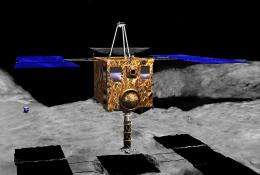Japan's Hayabusa asteroid-chaser set for Outback touchdown

The inky skies over Australia's Outback will, for a brief moment on Sunday night, light up with a flash brighter than Venus as an asteroid-chasing Japanese space probe makes its delayed return to Earth.
The battered Hayabusa will complete a seven-year, five-billion-kilometre (three-billion-mile) journey in spectacular fashion shortly before midnight (1400 GMT), breaking up and incinerating as it re-enters the atmosphere.
Down below, scientists will wait to see whether Hayabusa, three years behind schedule and hit by technical problems, has managed to gather the first ever fragments from a moving asteroid, yielding vital clues about the universe.
"Hayabusa will be the first space mission to have made physical contact with an asteroid and returned to Earth," said Tommy Thompson, NASA's Hayabusa project manager based in California.
"The mission and its team have faced and overcome several challenges over the past seven years. This round-trip journey is a significant space achievement."
Hayabusa ("peregrine falcon" in Japanese) will dissolve into a fireball above Australia after releasing its sample canister, which is designed to withstand temperatures hotter than the sun's surface before floating down on a parachute.
It blasted into space in May 2003 bound for Itokawa, a potato-shaped asteroid 300 million kilometres from Earth, to collect dust samples believed to yield unprecedented information about the evolution of the solar system.
"Hayabusa is hurtling toward Earth at an immense speed, comparable to that of an asteroid impact," NASA's Peter Jenniskens said this week. "The spacecraft will break into numerous pieces, essentially making it a man-made meteor."
Jenniskens and a team of international astronomers will watch from a NASA jet at 39,000 feet (12,000 metres) as the 18 kilogram (40 pound) canister re-enters at a blistering 7.58 miles (1.93 kilometres) per second.
Hayabusa became the world's first spacecraft to land on and lift off a celestial body other than the moon after touching down on Itokawa, a "rubble-pile" asteroid, in September 2005.
But Japan's space agency JAXA is uncertain what, if anything, the 40cm by 20cm (16 inch by 8 inch) sample pod will contain, after systems designed to fire a pellet to stir up dust on the asteroid's surface malfunctioned.
NASA's Michael Zolensky said there was good reason to believe that the landing process alone would have kicked up enough dust for a sample, though he admitted the capsule was likely to return "less than a gram".
"When we open it up, I think it is not going to be empty," he said.
JAXA's early observations, using Hayabusa's on-board devices, show Itokawa's fragments smashed away from a larger body during a crash, and its parent body was formed in the solar system's embryonic stages.
"It's a primitive celestial body that contains elements of an ancient era,' JAXA said. "It was born between several tens of millions and hundreds of millions of years ago."
Once the dust pod is 10 kilometres above the ground it will shed its heat shield and deploy a parachute and homing beacon to signal its exact landing location in the Woomera rocket-testing range, in the central Australian desert.
Australian authorities will escort JAXA scientists to the touchdown site, and the capsule will be retrieved by helicopter, for air-freighting by jet to ground control at Sagamihara, west of Tokyo.
There, it will be x-rayed, analysed and finally opened by scientists from Japan, Australia and US.
JAXA will then have a one-year exclusivity period to study the sample under microscope and infrared spectrometer, as well as to analyse its chemical and mineralogical composition.
Zolensky said space dust from Itokawa could provide valuable insights into the development of the solar system and information which could help minimise potential asteroid impacts with Earth.
Hayabusa's mission was hit by serious technical troubles. It spun out of control and lost communication with JAXA for seven weeks, delaying its return for three years until the asteroid and Earth again aligned.
It is limping home on broken engines with wonky positional adjusters and faulty batteries, but Japan will welcome its return with thousands of devout fans lauding Hayabusa a national hero.
(c) 2010 AFP















